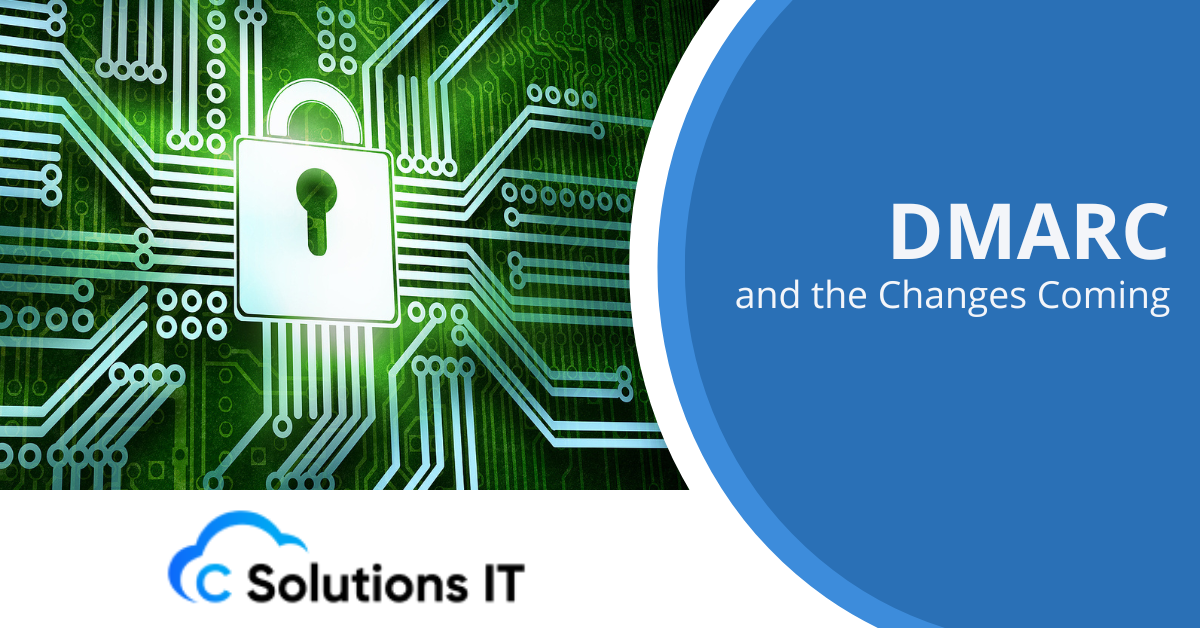DMARC and the Changes Coming

In the vast expanse of the digital world, email has been a cornerstone for communication, whether for personal conversations, business dealings, or marketing efforts. However, as much as email has been a tool for connectivity, it has also been a vector for fraud and phishing attempts.
To combat these security threats, protocols like DMARC (Domain-based Message Authentication, Reporting, and Conformance) have been developed and implemented. As the cyber landscape evolves, so too does the technology designed to protect it. In this article, we will delve into what DMARC is, the pivotal role it plays in email security, and the imminent changes we can expect.
C Solutions IT is at the forefront of adopting these changes to enhance our client’s email security posture.
Understanding DMARC
DMARC stands for Domain-based Message Authentication, Reporting, and Conformance. It’s an email validation system designed to protect your domain from unauthorized use, often known as email spoofing. The purpose of DMARC is to give email domain owners the ability to protect their domain from unauthorized use, thus improving the security of the email ecosystem.
How DMARC Works:
- Authentication: DMARC works by ensuring that the sender’s email messages are authenticated against the domain’s SPF (Sender Policy Framework) and DKIM (DomainKeys Identified Mail) records. This process verifies that the message comes from the legitimate sender and not an impersonator.
- Policy Enforcement: Once authentication is verified, DMARC applies the domain owner’s policy to either pass, quarantine, or reject messages that do not meet the domain’s specified criteria.
- Reporting: DMARC also provides a feedback loop, sending reports back to the domain owner about messages that pass and fail DMARC evaluation. This information is crucial for understanding and improving email security.
The Importance of DMARC
Email fraud and phishing attacks are on the rise, with attackers constantly finding new ways to breach security systems. DMARC serves as a critical line of defense against these threats by:
- Reducing the risk of email spoofing and impersonation attacks.
- Increasing the deliverability of legitimate emails by verifying their authenticity.
- Enhancing the visibility and control over the email ecosystem, allowing domain owners to make informed decisions about their email security policies.
The Changes Coming to DMARC
As we progress further into the digital age, the strategies and tools we use to secure our digital assets must evolve. DMARC is no exception. The changes coming to DMARC aim to address the evolving threats in email security, improve usability, and enhance the protocol’s effectiveness.
Enhanced Authentication Methods:
The future of DMARC includes the development of more sophisticated authentication methods. These advancements will provide a more robust framework for verifying the authenticity of emails, reducing the chances of spoofing and phishing attacks.
Improved Policy Enforcement:
Changes in policy enforcement mechanisms are expected to provide domain owners with more granular control over their email security policies. This will allow for more precise handling of emails that fail DMARC checks, reducing false positives and improving the overall email experience for users.
Greater Integration with Other Security Tools:
DMARC’s integration with other security tools and protocols is set to improve. By working in concert with technologies like BIMI (Brand Indicators for Message Identification), DMARC will not only authenticate emails but also enhance brand visibility and trust in the email ecosystem.
Advanced Reporting and Analytics:
Upcoming changes will also focus on enhancing the reporting and analytics capabilities of DMARC. This will provide domain owners with deeper insights into their email traffic, enabling them to detect and respond to threats more effectively.
Preparing for the Changes
As these changes roll out, it’s essential for businesses to stay ahead of the curve. Preparing for the upcoming changes involves:
- Regularly Updating DMARC Records: Ensure that your DMARC records are up to date with the latest policies and practices.
- Monitoring DMARC Reports: Actively monitor DMARC reports for insights into your email traffic and potential security threats.
- Educating Your Team: Make sure your team is aware of the importance of DMARC and the changes coming. Education is key to ensuring that everyone understands their role in maintaining email security.
Prepare For The Evolution of DMARC
The evolution of DMARC is a testament to the ongoing battle against email-based threats. By staying informed and prepared for the changes coming to DMARC, businesses can protect their digital assets and maintain the integrity of their email communications.
At C Solutions IT, we are committed to leveraging these changes to enhance our clients’ email security. Our team is dedicated to implementing the latest security measures and ensuring that your business remains protected against the ever-evolving landscape of cyber threats. For more information on how we can assist with your email security needs, please contact us.
